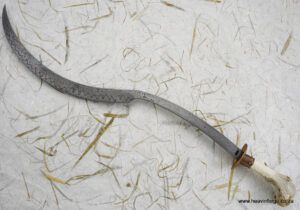October 7, 2024
I Want to Make a Sword!

“I Want to Make a Sword”—How to Encourage Aspiring Bladesmiths
October 7, 2024

“I Want to Make a Sword”—How to Encourage Aspiring Bladesmiths
September 6, 2024
Workshop ergonomics might not seem very important for the part-time bladesmith, but you will still gain interesting tips from this blog post. Ergonomics will evolve with the new tools and equipment you acquire (bladesmiths always need more stuff). Kevin and I have changed the layout of our workshop countless times, and when it comes to moving giant anvils, surface grinders, hydraulic presses, and power hammers, you want to be sure of their positions as you set up your shop. It isn’t easy to move these heavy, semi-permanent machines! Get it right the first time and work around them.
July 14, 2024
Did you know? Bladesmithing dates back over 4,000 years! This ancient art has been passed down generations. Consider dedicating some Sunday time to bladesmithing. Let the hammer’s rhythm guide you and the forge’s glow inspire you.
But remember to balance your enthusiasm with respect for others’ peace and family time.
July 10, 2024
Try to get into the habit of keeping your workbench tidy with each tool in its own place. Good craftsmen take great pride not only in their work but also in their tools.
June 24, 2024
In today’s interconnected world, where knowledge is abundant and innovation thrives, the ABS certification is both a hallmark of tradition and a springboard for further advancement.
June 17, 2024
The colours of the steel at various temperatures provide an approximate yet reliable indication of its heat, allowing the smith to adjust their technique accordingly.
June 17, 2024
The “critical temperature” is a pivotal point in the forging process. It is the temperature at which the steel’s crystalline structure transforms, indicated by a bright orange glow. Determining this temperature accurately is crucial, as forging above it can cause the steel to become coarse-grained and weak.
June 17, 2024
Heat the test section to critical temperature (the lowest temperature at which the steel loses its magnetism), quench it in oil, place it in a vice, and hammer it as if to break it. If it bends without resistance, it is mild steel; if it resists bending or breaks, it is hardenable.
June 16, 2024
The two primary types of forges are gas forges and coal forges. Each type operates differently and offers distinct advantages and challenges. Understanding these differences is key to selecting the right forge for your needs.
June 16, 2024
Utilize steel apps and online resources to stay updated on steel properties and manufacturer specifications. However, ensure the information comes from reliable sources, preferably the steel manufacturers themselves.